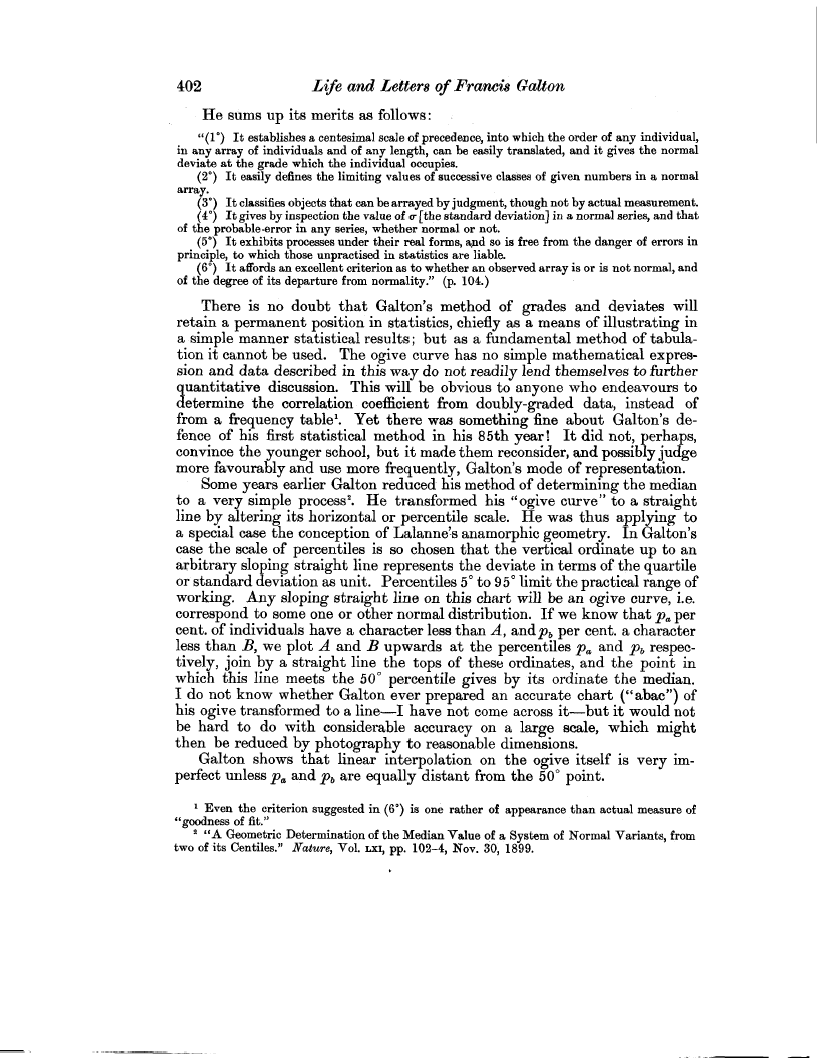402 Life and Letters of Francis Galton He sums up its merits as follows
'"(1°) It establishes a centesimal scale of precedence, into which the order of any individual, in any array of individuals and of any length, can be easily translated, and it gives the normal deviate at the grade which the individual occupies.
(2°) It easily defines the limiting values of successive classes of given numbers in a normal array.
(3°) It classifies objects that can be arrayed by judgment, though not by actual measurement. (4°) It gives by inspection the value of v [the standard deviation] in a normal series, and that
of the probable-error in any series, whether normal or not.
(5°) It exhibits processes under their real forms, and so is free from the danger of errors in
principle, to which those unpractised in statistics are liable.
(6°) It affords an excellent criterion as to whether an observed array is or is not normal, and
of the degree of its departure from normality." (p. 104.)
There is no doubt that Galton's method of grades and deviates will retain a permanent position in statistics, chiefly as a means of illustrating in a simple manner statistical results; but as a fundamental method of tabulation it cannot be used. The ogive curve has no simple mathematical expression and data described in this way do not readily lend themselves to further quantitative discussion. This will be obvious to anyone who endeavours to determine the correlation coefficient from doubly-graded data, instead of from a frequency table'. Yet there was something fine about Galton's defence of his first statistical method in his 85th year! It did not, perhaps, convince the younger school, but it made them reconsider, and possibly judge more favourably and use more frequently, Galton's mode of representation.
Some years earlier Galton reduced his method of determining the median to a very simple process'. He transformed his "ogive curve" to a straight line by altering its horizontal or percentile scale. He was thus applying to a special case the conception of Lalanne's anamorphic geometry. In Galton's case the scale of percentiles is so chosen that the vertical ordinate up to an arbitrary sloping straight line represents the deviate in terms of the quartile or standard deviation as unit. Percentiles 5° to 95° limit the practical range of working. Any sloping straight line on this chart will be an ogive curve, i.e. correspond to some one or other normal distribution. If we know that pa, per cent. of individuals have a character less than A, andp, per cent. a character less than B, we plot A and B upwards at the percentiles Pa and pb respectively, join by a straight line the tops of these ordinates, and the point in which this line meets the 50° percentile gives by its ordinate the median. I do not know whether Galton ever prepared an accurate chart (" abac") of his ogive transformed to a line-I have not come across it-but it would not be hard to do with considerable accuracy on a large scale, which might then be reduced by photography to reasonable dimensions.
Galton shows that linear interpolation on the ogive itself is very imperfect unless pa and p, are equally distant from the 50° point.
1 Even the criterion suggested in (6°) is one rather of appearance than actual measure of "goodness of fit."
2 "A Geometric Determination of the Median Value of a System of Normal Variants, from two of its Centiles." Nature, Vol. Lxi, pp. 102-4, Nov. 30, 1899.

